Creative thinking inspires ideas. Ideas inspire change. — Barbara Januszkiewicz
In the new-ish omnichannel world of advertising that includes print, TV, social media, etc., great creative based on great ideas, good data, and a fearless approach to ideation is the lynchpin that leads to great campaigns that move and motivate audiences — patients and healthcare practitioners — to action.
Healthcare communications and advertising agency creative executives share their secrets as to what drives their creative juices, their keys to great creative executions, how they foster ideation, and what they appreciate about some of their peers’ favorite creative executions.
Getting Creative
Lacey Jae Christman
Fishawack Health
Great creative is effective creative. And effective creative is affective creative. Our creative philosophy has always been simple: to produce works that work. We strive to develop effective, impactful brand communications that deliver tangible results. As the great ad man Bill Bernbach said, “If it doesn’t sell, it isn’t creative."
And if you want to sell or change behavior, you need to reach your target audience with evocative creativity. That’s why we believe for creative to be truly effective, it first needs to be affective.
Our creative approach is affective creativity. Creative crafted to make deep, motivating connections with our target audience. We tap into psychology and combine that with creative craft and expertise to deliver powerful, engaging work on a conscious as well as a subconscious level.
We’re learning more and more about the power of creativity itself every day. One study found that creativity can double the impact of every marketing dollar spent. That’s powerful stuff.
Renata Florio
Ogilvy Health
Great creative is a combination of a unique idea and impeccable execution that conveys the right message for everyone who experiences it.
In other words, it’s something that everyone looks at and says, “Wow, what a great idea!" — from chief medical officers and CEOs, to adults, children, and everyone in between, regardless of race, gender, sexual orientation, or moment in time.
“Moment in time" is a particular distinction because great ideas are timeless.
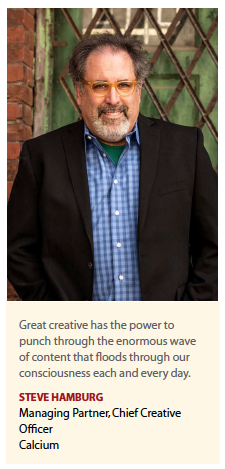 Steve Hamburg
Steve Hamburg
Calcium
Great creative has the power to punch through the enormous wave of content that floods through our consciousness each and every day. Through sheer force of idea and execution, great creative reaches us in ways that mere information or content can’t. Great creative opens our hearts and minds rather than shutting them down.
Great creative also is fundamentally unignorable. It causes a kind of explosion inside of us, and we find ourselves awakened out of a cognitive slumber, alert and ready to be engaged.
Great creative is powered by ideas that are brought dramatically and seamlessly to life through the highest levels of visual and verbal craft. And, while words and pictures matter a great deal, without that vibrant core idea, great creative deflates to become simply creative — and it fades into that vast, dull wave of content.
Susan Perlbachs
Intouch Group
Great creative advertising is the flawless intersection of idea and craft. It doesn’t demand your attention, because it doesn’t have to. You willingly give it. You might even pay to see it. Thus, the entire business model of Lürzer’s Archive of communication arts.
Great creative provokes thought. In its most elegant form, great creative allows the audience to arrive at the intended communication on their own, versus telling them what to think or believe. Above all, great creative executions look as if they were always destined to turn out exactly as they did.
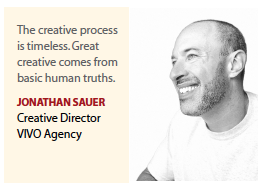 Jonathan Sauer
Jonathan Sauer
VIVO Agency
Great creative is activating. It seizes emotions and sparks an immediate response, whether assertive action or a simple shift in mindset. That’s because great creative compels you to see the world differently. It moves you to bring a better vision to life. It’s more than interesting, it’s more than clever, it’s a true reflection of your world, from the inside out. It’s not manipulative, but human. That’s why great creative makes a profound connection, and is truly unforgettable. It gets you — gets inside you. Great creative activates you to bring to life what you’ve been missing. You may not know why or how it happened, but the impact is powerful. And you’ll never be the same.
Creating the Creative Process
Jonathan Sauer
VIVO Agency
The creative process is timeless. Great creative comes from basic human truths. But the outside world has forever changed. For a campaign to change behavior, a whole new type of thinking is required. One that achieves a level of engagement that fulfills audiences and drives business.
We can no longer simply come up with static creative ideas that can be applied to tactics. More often, today, the engagement is the idea. We need to be thinking more broadly and deeply about holistic brand experiences that transcend media and that cohesively bring stories to life across virtual, physical, and personal channels. With more thought leadership, strategic partnership, integration with social media, and even alignment with greater causes. And that can be measured.
So, what’s the same? Creativity. What’s different? Everything else.
Steve Hamburg
Calcium
New media have broadened the creative canvas on which we work. So, our ideas must be more flexible and transportable, exerting the same gravitational force independent of the particular format or channel we’re working in. And, we need to be very well attuned to the nuances of each medium; for instance, what creatively works in a CVA won’t work the same way in a :60 broadcast spot or banner ad.
Yet, despite the rapid evolution of digital media, the fundamentals of creative thinking remain largely unchanged. We need to ask the same questions. How do we use language and imagery inventively so that they rivet attention? How do we engage individuals with ideas as opposed to just information or content?
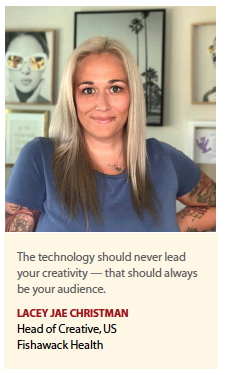 Lacey Jae Christman
Lacey Jae Christman
Fishawack Health
Technology changes, but humans don’t. And that’s an important point about technology. The creative industry tends to be obsessed with the new. We love the latest tech, the latest “thing."
“This changes everything" is something we all hear ad nauseum. And yet humans haven’t really changed since homo sapiens first emerged.
Again, as Bill Bernbach observed, “It took millions of years for man’s instincts to develop. It will take millions more for them to even vary. It is fashionable to talk about changing man. A communicator must be concerned with unchanging man, with his obsessive drive to survive, to be admired, to succeed, to love, to take care of his own."
That’s why we should be obsessed with the customer, not the technology. Provided your audience is at the heart of your idea, then technology is just a means to connect with them. Of course, you need to understand how they use the technology, why they use it, what they’re getting from it. But the technology should never lead your creativity — that should always be your audience.
Susan Perlbachs
Intouch Group
The basic principles stay the same. Idea and craft drive the overall experience. However, how ideas begin or how we leverage craft changes. The idea of “fast-vertising" has become increasingly valuable in social media, allowing companies to gain connections and relevance by leveraging pop cultural trends. For example, Aviation Gin running its Peloton holiday spoof within 72 hours on social media generated tremendous discussion and brand recognition.
Additionally, the idea of craft shifts. For example, in social media, an unpolished, user-generated content look may be the best execution for the brand.
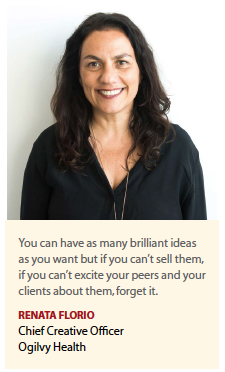 Renata Florio
Renata Florio
Ogilvy Health
The creative process has become more inclusive and expansive, allowing different creative talents to come together and concept together. There are so many ways to bring ideas to life, so you need many different types of thinkers: writers, designers, art directors, technologists, social media experts, influencer media experts, behavioral scientists, strategists, e-commerce experts, and more. I mean, it’s a pretty long list of talents, which is a significant change from how it used to be — and it’s a good change. And it never stops. I tell my teams that this is the most exciting time to be a creative.
You can think of anything, and there will be someone who knows how to concept against it with you and make it happen.
Best Practices to Encourage Ideation
Lacey Jae Christman
Fishawack Health
Although creativity can be magical, coming up with ideas is anything but. It all starts with a great brief. Creatives need clarity, direction, and inspiration. An inspirational brief, built upon deep insight, will ensure that your creatives are thinking of ideas before you’ve even finished the verbal briefing. The other thing you really need is in shorter supply these days — time. To think of truly exceptional and breakthrough ideas, your brain needs permission to think and explore. James Webb Young’s seminal 1965 work A Technique for Producing Ideas lays it out best. He emphasizes that the best ideas come when you stop consciously thinking about the brief. That’s when your subconscious kicks in and starts making creative connections.
It’s a cliché that we have our best ideas in the shower, but it’s not far off. Some of our best ideas tend to come anywhere but at our desks — or nowadays our home office, kitchen table, or couch.
Of course, we don’t always have the luxury of time. Sometimes we need to move faster and pool our resources. But then the preparation work and the brief needs to be even more tightly screwed down. We’ve developed various brainstorming formats designed to get initial ideas quickly and to a decent standard, including Pack Hack, Scamper, and the 1-2-3 Interval technique. But be careful, the solution to your problem will likely not come out of your brainstorming session.
Brainstorming will reveal different avenues and undeveloped ideas that will help you get to the best solution. It will jump-start brains and fill minds with stimuli, but the road ahead is still long, with more ups and downs.
At the end of the day, ideas take shape and are crafted through the hands of individuals and dedicated teams. Someone needs to write it up, sketch it up, comp it up, deck it up. Check it.
Renata Florio
Ogilvy Health
Establishing the freedom to say whatever comes to mind is fundamental. Fearlessness comes right with it. You can feel free but still be afraid of how an idea may make other people feel. But we should be brave when concepting.
Another part of the ideation that people sometimes forget is the selling of the concept. You can have as many brilliant ideas as you want but if you can’t sell them, if you can’t excite your peers and your clients about them, forget it. When a creative comes up with a good idea, I say, “Now let’s go sell it." It’s important to question ourselves. What do we need to say or do to get as many people excited about it as we are?
Steve Hamburg
Calcium
Collective or group ideation is a powerful tool, but we should never ignore the role of individual ideation when it comes to doing great creative. The proverbial terror of the blank sheet of paper or computer screen is highly stimulative of the best thinking.
Pondering a creative challenge in the quiet of one’s own mind can help clarify ideational pathways to pursue. This creates a bank of raw ideas which, when brought into more collaborative settings, can further blossom into breakthrough concepts.
Another powerful ideational tool is paradoxically simple: just looking around. Take a walk and observe all the things in the physical environment we normally take for granted. Or, take a trip online to a new and different destination.
By focusing our conscious thoughts on external things, we can allow our unconscious to roam freely and work its magic. Suddenly, that oak tree, street musician, or Instagram image we’ve been focusing on channels our unconscious thinking and can spark a genuine concept into being.
Jonathan Sauer
VIVO Agency
Don’t start with creative. Start with insights. Great execution that doesn’t channel the truth is like a sugar rush. It spurs a surge of attention that subsides just as quickly. Because it doesn’t reflect your world. It reflects marketing — and falls flat.
At our agency, we spend the time it takes to get to the truth, not just customers’ actions and conscious thoughts, but the insights they themselves often don’t see.
These are the deeper drivers that can disrupt and dislodge bias, even if it makes them feel uncomfortable. So we learn everything we can about our customer; get together and break them down; and engage each other about their needs and truths. It’s all about flow, not holding back, but streaming thought. By connecting the dots, we move each other’s minds forward.
And often, we come up with the brightest ideas before we know they’re ideas. The simplest notion said in passing that lends itself to a brilliant concept. In many cases, the idea is so ele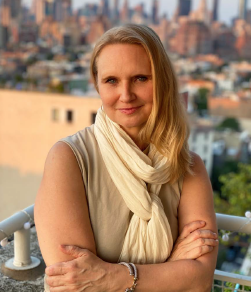 mental and powerful, executing is the easy part.
mental and powerful, executing is the easy part.
From insight and inspiration come the seeds of great creative. You just have to nurture them, and recognize greatness when it sprouts.
Susan Perlbachs
Intouch Group
First, it’s about partnership — believe in the sanctity of the art/copy partnership. “Group think" rarely generates production-worthy ideas. Second, it’s about time. Is the first idea the Cannes L ions winning idea? Maybe, but, more often than not, we need time. Time to pursue avenues that aren’t the first thing everyone thinks of.
ions winning idea? Maybe, but, more often than not, we need time. Time to pursue avenues that aren’t the first thing everyone thinks of.
Finally, surprise yourself. Never underestimate the ability to give yourself permission to do something unexpected. There’s a lot of talk about “what they want" when we talk about our clients. Sometimes it’s more important to talk about “what they need." And yes, you may end up having to present a little bit of both. (PV)
~~~~~~~~~~~~~~~~~~~~~~~~~
Key Elements for a Great Campaign
 Lacey Jae Christman
Lacey Jae Christman
Head of Creative, US, Fishawack Health
Here’s what we now know for sure from the science: creativity sells; concepts and storytelling are the most effective ways of conveying information — and the better the idea, the better the impact; people are motivated by conscious and subconscious goals, which strongly influence choices; 95% of decisions are made subconsciously; and emotions drive action. We also know craft matters. For example, the active voice is more powerful than the passive; something labeled “tender chicken" is more desirable than just “chicken." Visually, we know that certain colors evoke certain emotions and that shared cultural concepts can be powerful shortcuts to subconscious connections. When it comes together, and you hit that affective sweet spot, the result is strategically sound and effective creativity.
 Renata Florio
Renata Florio
Chief Creative Officer, Ogilvy Health
I think it’s the same for great creative and a great campaign — it has to be unique exciting, different, and mean something to whoever experiences it. Great campaigns are noticed, shared on social media, and become a part of people’s everyday lives. Again, it should resonate with all sorts of people, from all walks of life — everyone.
 Steve Hamburg
Steve Hamburg
Managing Partner, Chief Creative Officer, Calcium
A great campaign must show us some slice of the world in an utterly new and arresting way. It must create a vision that we haven’t encountered before, one that transports us to new kinds of knowledge and new ways of feeling. It must conjure conceptual, visual, and verbal magic that’s impossible to ignore and difficult to forget. It must captivate us totally. However, a great campaign is more than a great single idea or concept. It’s a great idea that manifests itself into a variety of different communications. It’s a symphony with different movements or a novel with different chapters. There’s a core creative idea that’s big and rich enough to capture and sustain interest through many iterations and over an extended period of time.
 Susan Perlbachs
Susan Perlbachs
Chief Creative Officer, Intouch Group
A great campaign includes the idea, craft, clarity, succinctness, and campaignability. The Absolut Vodka campaign is a case study for the ages.
 Jonathan Sauer
Jonathan Sauer
Creative Director, VIVO Agency
Customer insights are no longer enough. Marketers have an expanding set of considerations to ensure campaigns don’t just resonate, but truly activate. A campaign needs to be direct. In an age in which mass media has taken a back seat to social media, expectations have evolved. People want to feel personally connected. Media and messaging have to be direct — segmented, customized, and highly relevant. It needs to be engaging. Social channels are driving people to look for meaningful dialogue with brands, not just be on the receiving end of one-way communication. Today, brands need to exist in the living world and foster dynamic engagements. It needs to be integrated. People want brands to be integrated into their lives, and for brand touchpoints to be integrated with each other, all to bring fluid and fruitful experiences to life. Finally, it needs to be optimizing. Even the most extraordinary campaigns can underperform if they don’t have metrics in place. As brand experiences become more fluid, this is critical for driving engagement. Continuous optimization not only helps deliver on campaign goals, it ushers in a new era of marketing discipline and accountability.
~~~~~~~~~~~~~~~~~~~~~~~~~
The Gallery
Agency creatives share examples of great creative campaigns and why they work.
Lacey Jae Christman
Head of Creative, US, Fishawack Health
One shining example of a campaign that hits the affective sweet spot is the Melanoma Likes Me campaign from WPP in Australia. (https://www.youtube.com/watch?v=AGL3Pz_98xQ)
Melanoma haunts outdoor, in-the-sun Australians. It’s the most lethal cancer for those between 15 and 30. To reach this elusive group, George Patterson Y&R created a mobile campaign for Melanoma Patients Australia, called Melanoma Likes Me. It’s an application that uses popular sun-related hashtags and geolocations for posts from young Australians in the sun. Then, the creepy online persona “Melanoma" would “like," “follow," and comment, in real time.
It’s a brilliantly creative way to make an impact with the key target audience in an environment where they operate. Using social media as a vehicle to personify melanoma and physically demonstrate the way it sneaks up on you, unsuspected, is just inspired.
It’s affective and effective — so simple, so clever, so insightful.
And even though it uses the technology superbly, the idea is built around the audience first — where they are and what they’re doing and how to get their attention.
Renata Florio
Chief Creative Officer, Ogilvy Health
The “Take it from a fish" campaign resonates with me because of its uniqueness, the fearlessness of it, and the fact that it is timeless — it’s been five years and it would easily work today. I bet many people originally thought, “Are you sure we want to use dead fish to teach men about triglycerides?" It’s entertaining to different audiences, memorable, and it is brave. And it uses humor, which is the cherry on top for me. One might say creating for unbranded is “easier," so I want to share a branded example as well — ThisAbles. Through this project, Ikea was able to push its mission to a much higher level, showing us that pharma, health, and wellness can be tools for all brands that are concerned with a more inclusive and caring world.
Steve Hamburg
Managing Partner, Chief Creative Officer, Calcium
The recent “Prescribed to Death" stopping everyday killers campaign addressing the opioid crisis has won many awards — and justifiably so. The crisis itself is highly charged with import and emotion. Yet, the campaign manages to bring the crisis — literally — down to a human level, so that the tragedy of it is amplified, but in a very honest and poignant way. Moreover, this was a campaign with a very wide wingspan; it generated a tremendous variety of touchpoints and experiences, yet all of them tightly unified in terms of message and tone. Brilliant work that also spurred positive change. What more can you ask for?
Susan Perlbachs
Chief Creative Officer, Intouch Group
As a proud New Yorker, the new “State of Respect" campaign for the MTA really spoke to me. I don’t ride the subway much these days, but I caught a look at it on my way to a socially distanced picnic. It filled me with pride that respect for others does motivate New Yorkers to change behavior — instead of espousing individual rights to spread disease to others. Go Team Masks!
Jonathan Sauer
Creative Director, VIVO Agency
A campaign that caught my eye is “Facing Emotions," for the company Huawei, by Digitas Poland. It promotes a visionary solution for the visually impaired, one that helps them “see" emotions: a smartphone app that scans faces and delivers a short sound to the user that helps them sense others’ expressions.
The campaign is a sight to see. It starts with the AI-powered app, designed to be as simple as it is sophisticated. It continues with a physical experiential component — a specialized necklace-pouch phone case that positions the phone for continuous, seamless use. It was promoted with a documentary that tells the brand story, an emotionally charged video that expresses how the solution has changed the lives of real users, and a global social campaign to drive action. The campaign helped garner more than 340 million media impressions worldwide.
What draws me to this? It transcends marketing. It’s not just a nicely designed ad — the brand is the experience. It has virtual and physical components that mesh flawlessly with peoples’ lives. The campaign is not just promotional, it’s embedded in the product and its daily use. A beautiful big idea that’s engaging by its very nature.
Can you hear me smiling?


















